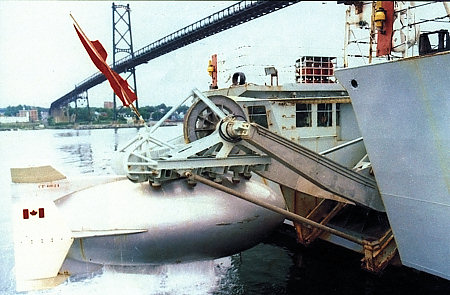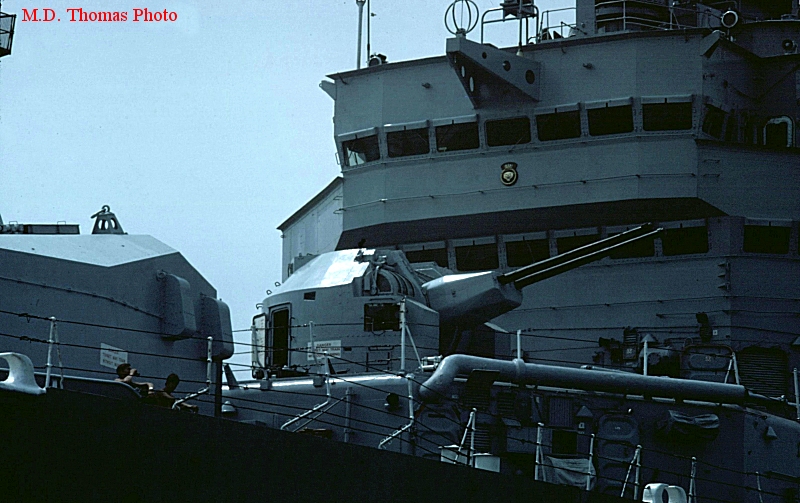To finish up the tour of IROQUOIS, I will walk through some of her exterior features and equipment. When the IROQUOIS class received the TRUMP refit in the 1990s, they were optimized for Air Warfare, but retained the Undersea Warfare capability originally fitted, and had limited Surface Warfare capability. Some of the photos here go back to the 1990s, and may have been taken on ATHABASKAN. My understanding of these systems is very basic, so my descriptions will not be very detailed. Which is probably just as well.
Undersea Warfare:
Designed as anti-submarine destroyers, IROQUOIS and her sisters were fitted with the latest in Canadian sonar equipment, originally the Computing Devices Canada (CDC) SQS-505 hull-mounted and variable depth sonars. These were later upgraded to the SQS-510 model. A number of years ago, I wrote an outline on RCN sonar systems
here.
 |
| SQS-510 Hull Outfit C3 sonar dome, removed for maintenance. The fairing itself is seen at bottom left, and is facing backwards. |
Unlike the huge low-frequency bow-mounted sonar domes favoured by the US Navy and others, the RCN currently uses medium-frequency sonars in a smaller faired dome, situated just forward of the bridge. In previous classes, the sonar dome was originally designed to be retracted into the hull to reduce the ship's draft when entering port, but they were later fixed in the down position. I believe IROQUOIS was designed with the dome in a fixed position. This means that special care must be taken when dry docking these ships, to the extent that the graving dock at the Halifax Shipyard has wells cut into the bottom to accommodate the sonar dome and the propellers of these ships.
IROQUOIS also carried a second SQS-505/510 in a Variable Depth Sonar (VDS) system fitted at the stern.
 |
| SQS-510 towfish and launching gear. Note the faired cable that would lower the towfish to depth. |
 |
| The VDS launching gear was installed in a cut-out in the transom. The operator worked behind the windows on the port side of the well, and the two ports on the starboard side are for the Nixie torpedo decoy. |
The launching derrick would lift the towfish off its cradle, and
pivot out over the stern
to lower the towfish into the water. The towfish would be lowered to an appropriate depth via a faired cable, and would provide better detection abilities than the hull-mounted sonar as it would be not be affected by hull noise, and could be lowered below thermal layers that might mask the presence of a submarine.
 |
| Towfish being launched. Image courtesy of Corvus Publishing Group. |
VDS was a Canadian Development in the 1950s, and was adopted by several other navies before being supplanted by towed array sonar systems such as the SQR-19 / CANTASS towed array sonar fitted to the HALIFAX class. The VDS was removed from the IROQUOIS class sometime in the first decade after 2000.
 |
| VDS towfish cradle after removal of the VDS. |
Once a submarine had been detected by sonar, Mk.46 lightweight torpedoes could be deployed against it from either the ship itself or a Sea King helicopter.
 |
| Starboard Mk.32 triple torpedo launcher. |
Unlike the fixed double Mk.32 launchers that fire at 45 degrees out the forward corners of the helicopter hangar on HALIFAX class frigates, the triple Mk.32 launcher on the destroyers was trainable and had to be directed out over the side. It is shown here in the stored position. Compressed air would be used to force the torpedo out of the tube and into the water, from where it would deploy its own motor and hunt for a target.
 |
| Air droppable Mk.46 lightweight torpedo. A parachute is fitted in the cowling over the propeller nozzle. |
The Mk.46 torpedo could also be carried by a Sea King helicopter, and air dropped with the help of a parachute that would detach when the torpedo hit the surface. These lightweight torpedoes are much smaller than the heavyweight ones carried by submarines.
Air Warfare:
Originally fitted for point-defence against aerial threats, the IROQUOIS class was refitted under TRUMP with area air defence systems that could extend an umbrella of protection to other ships operating in a task group, or to defend a convoy. First, all the radars were upgraded as part of that refit. (I have also written a summary of
radars and
fire control system used by the RCN over the years).
 |
| The main mast is bristling with sensors and other antennas. |
Antennas for all of the primary air warfare sensors can be seen in the photo above. Looking from bottom to top, there is the port WM-25 Separate Target Illumination Radar (STIR), the LW-08 (AN/SPQ-502) long range air search radar, two navigation radars, and then the DA-08 (AN/SPQ 501) air/surface search radar antenna on the top of the main lattice mast.
 |
| Port WM 25 STIR, with LW-08 in the background. |
IROQUOIS carries two STIRs, port and starboard over the bridge. These would track and designate or "paint" targets for the ship's weapons systems, after being detected by the ship's other air defence radars. All the radars are gimbal-mounted to allow them to maintain a level disposition while at sea.
 |
| LW-08 long range air search radar |
The LW-08 and DA-08 are the primary air defence radars, the former optimized for the long range detection of aerial targets, and the latter mounted higher on the main mast to provide better over-the-horizon aerial and surface detection. I believe the bar piggy-backed on top of each antenna dish is an Identification Friend or Foe (IFF) device.
 |
| DA 08 air/surface search radar. |
The primary air defence weapon is the Standard SM-2MR missile, deployed via a 29-cell Mk.41 vertical launch system (VLS).
 |
| Mk.41 VLS. |
Each cell of the 29-cell launcher can fit one SM-2 missile, or four RIM-162 Evolved Sea Sparrow Missiles (ESSM) in a quad-pack. Although the ESSM has now been added to the HALIFAX class ships in their Mk.48 VLS, I do not know if the IROQUOIS class has ever carried them. The launcher actually has room for 32 cells, but three cells are taken up by a strike-down crane (third row in, on the right of the photo above). This crane is apparently never used, and has been removed from later launchers in favour of three additional cells. In way of comparison, a USN BURKE class destroyer carries up to 3 of these launchers.
As an aside, the only vertical launched Sea Sparrow missiles that I am aware of ever being deployed from an IROQUOIS class ship was the 1981 testing of the Mk.48 VLS from HMCS HURON. I have seen a photo somewhere, as I recall showing two Mk.48 cells fixed to the side of the old Sea Sparrow launcher used by these ships pre-TRUMP.
Secondary air warfare defence is provided by both the OTO Melara 76mm gun, and the 20mm Phalanx Close-In Weapons System (CIWS). (Another version of this acronym that I have seen reads "Christ, It Won't Shoot").
 |
| Phalanx CIWS. |
The Phalanx is a self-contained unit combining a 20mm gatling gun with a radar system, and is easily bolted onto ships that weren't necessarily designed to carry them. They are intended as a last ditch weapon to try and stop missiles ("leakers") missed by the primary missile system. The RCN retrofitted its Phalanx systems to the Block 1B standard, complete with the camera mounted on the side of the radome to help provide anti-surface capability.
IROQUOIS also carries four Plessey Shield flare and chaff launchers just aft of the bridge, and was also retrofitted with the Australian Nulka active missile decoy system.
 |
| Nulka launcher on the quarterdeck of ATHABASKAN in 2010. |
 |
| Port Nulka launcher aft of the bridge of ATHABASKAN in 2010. |
IROQUOIS can carry up to four Nulka launch cannisters, two port and starboard behind the bridge, and two side-by-side on the quarterdeck just aft of the helicopter deck. Nulka launches as a rocket from the cannister, but then can hover away from the ship and attempt to draw incoming missiles away from the ship. I was under the impression that the RCN did not buy enough units to fully equip all ships of the class, and would trade them off between the ships (on the East Coast at least).
Surface warfare:
Lacking dedicated anti-surface missiles like Harpoon (although I believe the SM-2 missile can be used against a surface target in a pinch), IROQUOIS relies primarily upon her 76mm gun and Phalanx CIWS (supplemented by .50 calibre machine guns for small surface craft). A summary of other gun systems used by the RCN over the years can be found
here.
 |
| OTO Melara 76mm Super Rapid gun. |
The Super Rapid version of the gun can fire 120 rounds per minute, and is improved over previous mountings to help counter anti-ship missiles as well as surface targets. The gun has a dedicated fire control system in the Lightweight Radar/Optronic Director (LIROD).
 |
| LIROD. |
The LIROD is mounted between, and slightly forward of, the two STIRs.
This concludes, at least for now, my photo tours of IROQUOIS. I finish writing this just in time on April 25, 2015, less than one week before IROQUOIS pays off on May 1, after which 43 years of being "Relentless in Chase" will come to an end.

















































